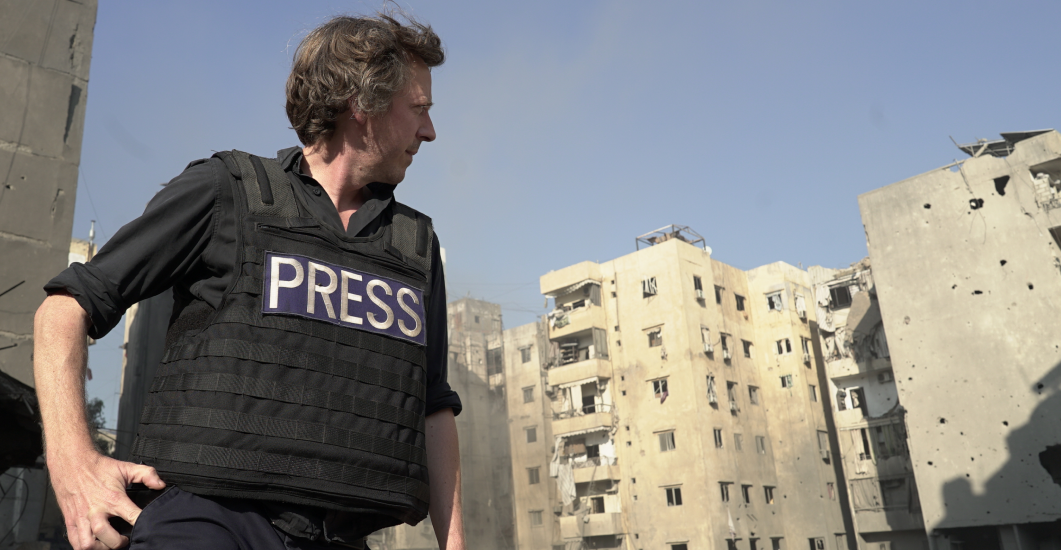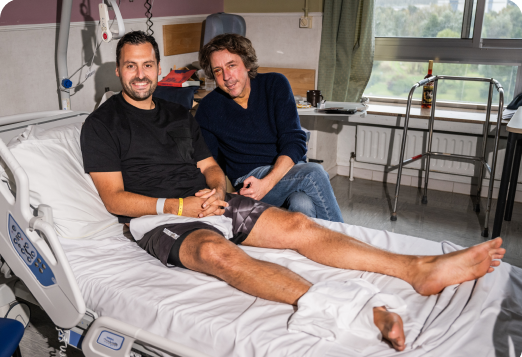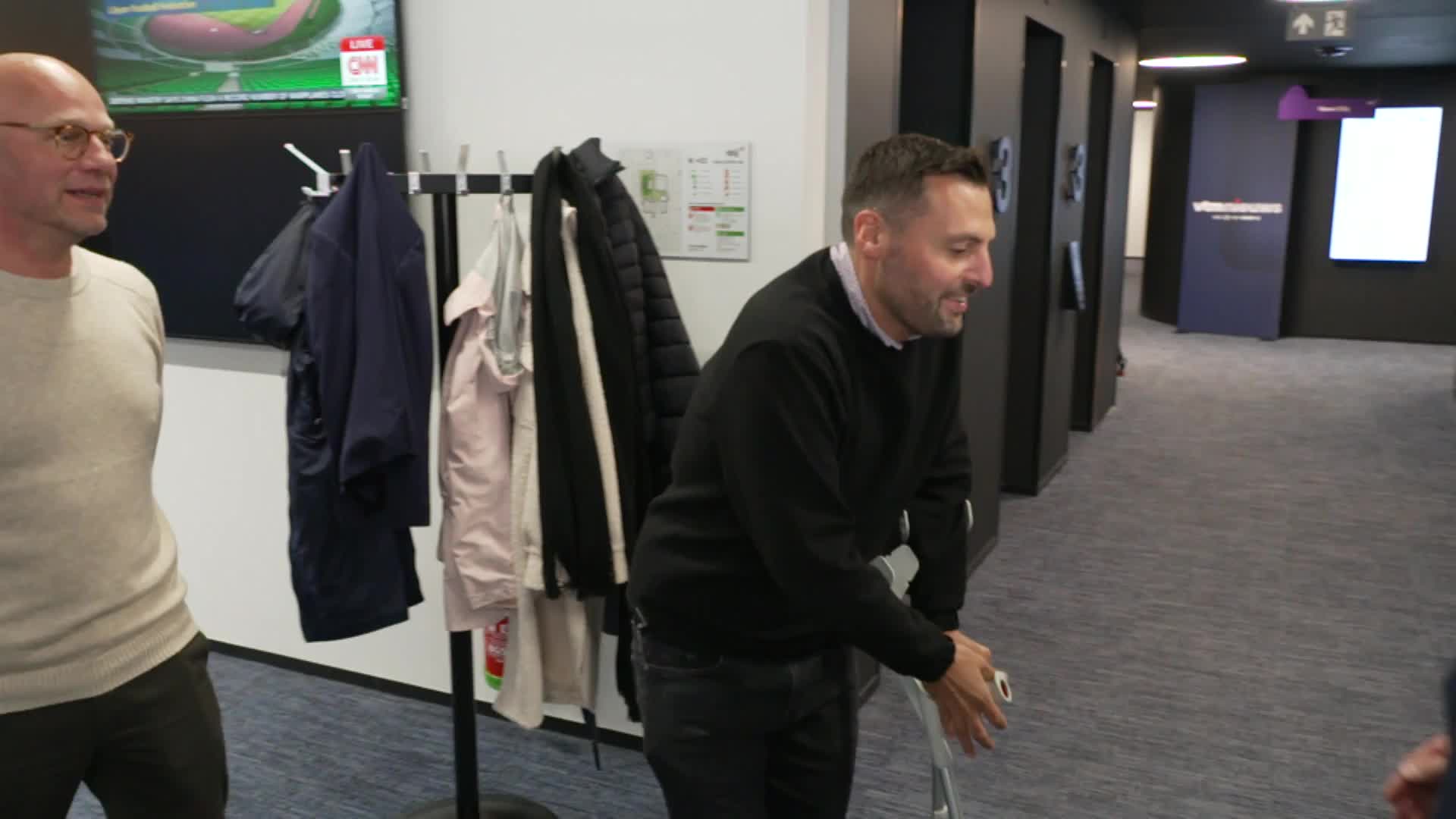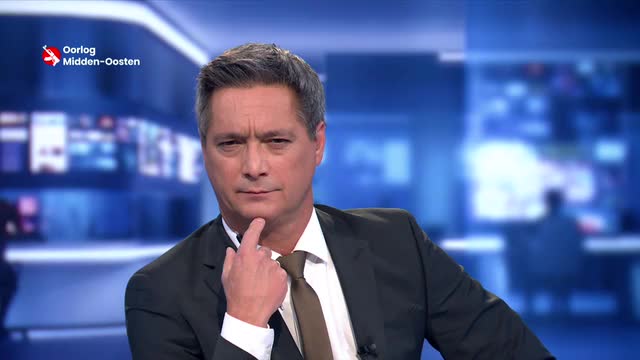VTM NIEUWS Annual Editorial Report 2024
What kind of risks are acceptable when it comes to war reporting? When do you tell your people to come back home? And how did VTM NIEUWS emerge as the real winner of last year’s elections?
Looking back at 2024
No story is worth dying for
How far do news networks go to report from war zones? The experiences of journalist Robin Ramaekers and camera operator Stijn De Smet highlight not only the huge risks war correspondents face, but also why their presence in conflict-hit areas is crucial. An ethical dilemma: when does getting a story cross a line?


Stijn and Robin
S
tijn has disappeared. We don’t know whether he’s still alive.” It’s the middle of the night when a call from our head of foreign affairs jolts me awake.
It’s about Stijn, the camera operator currently filming in Beirut with VTM NIEUWS correspondent Robin. A missile had struck nearby their hotel that night. After they had rushed to the scene, things got seriously out of hand. Shots were fired; chaos ensued. The boss tells me Robin had been beaten and taken in for interrogation. He’s injured and on his way to hospital.
But where’s Stijn?
We quickly form a group and, at four in the morning, start ringing around Beirut’s hospitals. Over three hours later, a Lebanese nurse at one of the capital’s A&E departments finally utters the words: “Stijn De Smet? Yes, he’s here. I’ll put him in a wheelchair and bring him to the phone.”
Robin and Stijn’s story goes global. TV stations dispatch teams to Antwerp’s Mediaplein square, the city’s media hub, to gather comment; reporters are standing glued to their phones. I even find myself speaking on our own news programme. Anchor Freek Braeckman asks me a series of unavoidable questions: “Did we, as editors, do enough to prevent this situation?” and “Why are we taking these sorts of risks?”
My answers are candid. There is no doubt that we sent experienced people, each one having followed special training, to pursue their work in war zones. When they’re looking down the barrel of a gun, they know exactly what to do.
Dilemma
When Robin and Stijn later return to the safety of Belgium, they agree with my response. They remained calm and knew they should keep talking; they had to do their best to remain composed. For now, they appear to be managing the psychological and physical toll well.
Our motives for being in this line of work are clear – in fact, they have never been clearer. In an age of social media awash with dubious photos and videos, journalists providing objective reporting on the ground play a crucial role. That includes reporters at the big media outlets like CNN or the BBC just as much as our team. We are a news broadcaster with a global outlook, because we know that news has no borders.
Robin is already back in Syria, and Stijn intends to return once fully recovered. Giving Robin permission to head back out was a tough decision. We want them to be back in the field, but we also feel an overwhelming sense of responsibility. We are the ones who make the final call; we are the ones who allow them to go.
The risks are easy to downplay in the heat of the moment, but events in Lebanon have pushed them into full view. From one second to the next, you find yourself answering the calls of Stijn’s distraught father, hearing he’s been shot. Or you’re sitting with Robin’s wife in the hospital waiting room, eager to hear news of his injuries. We know exactly what’s at stake.
It’s a dilemma that will raise its head with each foreign mission, and we must keep having that discussion. The one thing we can agree on was said in Robin’s very first response: “No story is worth dying for.”
Kim Herbots
Editor-in-chief of
VTM Nieuws

The wall
New: Studiorepo
W
e’ve been doing it for a while in VTM NIEUWS: putting a journalist in front of a giant screen and explaining a topic. We call this a wall of explainer. The graphics team put a lot of effort into it, and often the result was fine – but at times, it still felt a bit like a staged performance.
When we began our redesign in September, we made a conscious decision to elevate that visual wall as well – bringing in more depth and greater variety. Instead of relying solely on standard charts and figures, we now incorporate drone footage, expert commentary, personal stories from everyday people, and, above all, many visuals.
Each day, we choose one question linked to a topic in the news and work on it in depth. One week it’s Carl Theunis hosting our so-called studiorepo, the next it’s newcomer Meryem El Mandoudi taking the lead.
If your child makes a false bomb threat, who should pay the cost? What do Blue Helmets do? Which checkout system is most efficient: queuing or self-scanning? By zeroing in on one specific question each day, we stay true to our promise to viewers – helping everyone learn something new, every single day.
view an impression

Elections
The winner
An intimate setting with two chairs, a minimalist backdrop that draws no attention, anchor Cathérine Moerkerke, and the winner of the election. Nothing more was needed to resolve an old wound on election night. VTM NIEUWS has faced the same challenge on election day for years: at around ten in the evening, the leaders of the political parties head to the public broadcaster for the final debate. And so does the viewer. “Find something that offers a strong contrast” – that was the assignment.
Election day is hectic. Not just for us, also for the viewer. After 14 hours of television, everyone needs a break – so why not shift the focus to the first long, quiet conversation with the winner, the only person who truly matters at that moment?
It was a logistical tour de force. We needed a studio that each party leader could easily access between their speech and the debate – and we had to convince the winner to join us on what is already an incredibly busy evening.
We pulled it off – and with results to show for it. ‘De Winnaar’ helped make VTM NIEUWS a winner on 9 June. Our market share rose by ten percent compared to previous elections, and we led the market throughout the day – and into the evening – among viewers aged 18 to 44.
The year in numbers
How high is our daily reach? How many articles do we write in a day and what rating does VTM NIEUWS get from its subscribers?
View all figures of 2024

